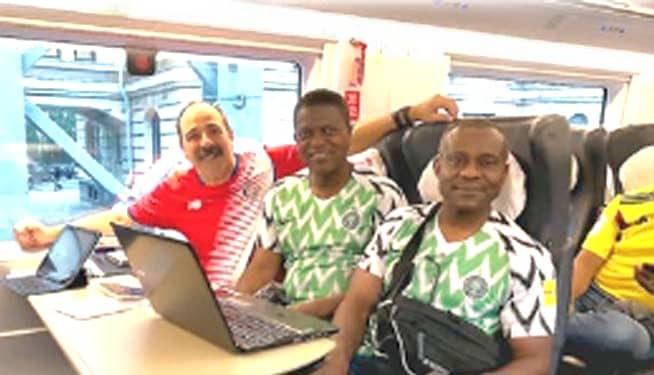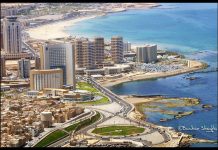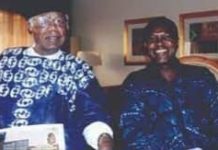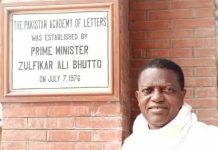I was a long way from home and after a few days watching soccer and sightseeing in Saint Petersburg, I would be heading north by train to the Russian capital city of Moscow.
The following days up in Moscow would be busy, filled with travelling mostly by the Metro, watching more soccer, sight-seeing museums and monuments, writing and trying out the Russian cuisine but being a teetotaller, I would avoid the famous Vodka.
In Moscow, I would be stopped by the Russian police for a brief interrogation, stung and choked by gas fumes in the Moscow Metro, beaten by a sudden rain shower when I wasn’t with my umbrella and stared at by some ‘skin head’ Russian youths who were not used to seeing strangers in their land.
On the sunny side of things, I would enjoy the company of many football fans who had come for the World Cup, get help from friendly elderly Russian women when communication in English became a challenge, eat delicious meals in roadside restaurants, sip lemon tea in the mornings in my hired apartment and hang out with my two travelling buddies, Tayo and Dion.
In short, I would have a wonderful time in Moscow.
But I had to get there first…
And so, at exactly 6.30 on a sunny June morning, the Sapsan, a Russian Gauge high speed electric express train slid majestically into Track 7 of the Saint Petersburg’s Moskovskiy Railway Station.
With its red, blue and white bullet shaped head, the 10 coaches, 250 metre long Train with a capacity for 604 passengers and a maximum speed of 250 km/hr was a beauty to behold.
As I waited on the platform of Track 7 for the train’s arrival, I could not but be captivated by the beautiful work of technology which was a far cry to the steam engine trains of the 60s when my childhood fascination with trains began.
And so when I found myself in Russia at the 2018 Football World Cup, I did all I could to have a taste of the famous Russian Railway already made famous by a league of renowned writers ranging from James Joyce, T S Elliot, Dostoevsky, Tolstoy to Paul Theroux to name just a few.
TWENTY minutes after docking into Track 7, the St Petersburg to Moscow Train took off on the 635km trip to Moscow. Travelling with me were my two US-based friends, Tayo and Dion. As we clambered on board the very clean and comfortable train, our International Passports and tickets were checked.
It was a lovely train with the seats in the Business Class coach, huge with ample space. There were also facilities to charge our phones and electrical gadgets. The food was also good with nice service.
Anyone who knows Russia will know that train journeys across its vast expanses are a quintessential part of experiencing the country and the character of its inhabitants.
Most of the passengers on the Spasan train, were made up of both the old and young who appeared to be students, tourists and businessmen.
Hardly had we settled into our seats when two stewardesses in neat and crisp grey coloured uniforms, Victoria and Vera (from their name tags) handed round the day’s newspapers.
Unfortunately, the papers were all in the Russian language. All the same, I got hold of one and tried to use the photographs in the papers to decipher what the news were all about.
After the newspapers, came a breakfast of Omelette, Bread, Salad, Orange Juice and Coffee which went very well in the quiet and comfortable coach.
As the train picked up speed, the electronic displaying board in the coach showed speeds rising from 120km/hr on to 180, 220 before settling down at 250 km/hr while the outside temperature was 27oc and the inside, 23oc.
Unlike the Locomotive and Diesel-powered trains of my childhood, it was not possible to have a good view through the window as the train cut through the Russian countryside at a dizzying speed.
All the same, it was still possible to see fast motion glimpses of the Saint Petersburg’s metropolis of skyscrapers and steel bridges as they raced past the train’s window.
We were soon in the Saint Petersburg’s suburbs of brick terraces and narrow back gardens, then past a row of semi-detached houses before being shot wonderfully into a new setting of sleepy villages and green farmlands interspersed with small houses against an expansive background of corn fields.
Inside the train, all was peaceful as the wonderful piece of engineering marvel became its own little tubular world; a world where rivers and lakes shining in the early morning sunlight slid past the window and the picture square pine forests became a wallpaper on the landscape of our journey.
Gradually, the countryside became more rolling and then, suddenly, as the train made a curve, it changed completely.
The forest, which for hours had formed a fence on either side of the train, opened up onto broad, beautiful plains, with walls of trees and the sky seemed to pull upward, flooding the scene with light.
In addition, very much unlike my favourite Nigerian trains where you could chat and laugh as much as you like, everything was boringly quiet, with many of the passengers engrossed with newspapers, books, mobile gadgets and sleep.
No pickpocket was arrested for working on passengers wallets, no stowaway was caught and thrown off the train and no chance to buy delicious food and snacks from hawkers on the station platforms.
All we did was to sleep and read and stare through the window of the fast moving train.
I was left to gaze into the fast-changing slices of the Russian countryside while the gentle rocking motion of the train acted as my lullaby and before long, I soon joined some of the passengers in the sleeping business.
When I woke up moments later, I went for a walk down the train to stretch my legs.
After two coaches, I stumbled on the canteen where a group of football fans in colourful Colombian jersey were making merry with food, beer and coffee. They were happy to see me in my very popular and beautiful green and white Nigerian jersey and invited me over for a cup of coffee.
As we chatted heartily about football and the games, I took in more scenes of the Russian countryside as glimpses of beautiful lakes, rivers, parks and trees flew past the window.
WE soon came to the town of Golgoya, where the train stopped for just a minute to discharge some passengers.
Moments after we took off again, I was roused from another slumber by a lady Ticket Inspector, Tatiana who glanced at my outstretch ticket, smiled and disappeared into the next coach.
The train was now going at 200km/hr, probably ascending a hill and before long, we passed Bologoe.
Outside Mockba, we passed forests of tall pine and cypress trees as we continued our journey into the vast Russian land, the largest country in the world by land size.
Beside me in seat 23 was the sleeping figure of Tayo while my third companion, Dion in seat 21 was busy with his iPad.
To keep myself busy, I stared out of the window for the umpteenth time as the train now passed several villages scattered across the Russian plain some dotted with tiny, self-sufficient hamlets with occasional sprinklings of the ubiquitous ‘dachas’ that Dostoevsky and Tolstoy idealised, Lenin despaired of, and Stalin tried to plan out of existence.
A ‘Dacha’ is a seasonal or year-round second home, often located in the suburbs of Moscow and other post-Soviet city. Although some dachas recently have been converted to year-round residences and vice versa.
I was soon brought out of my reverie at 10.40am by the announcement of the train’s arrival in Moscow.
Passengers were advised to keep their luggage safe and parents to hold their children well.
Highrise buildings, modern bridges and crowds of people now came into view as the train crawled into the Leningradsky Station and nosed towards track 7.
MOSCOW is a major political, economic, cultural, and scientific centre of Russia and Eastern Europe, as well as the largest city(both by population and by area) entirely on the European continent.
The city has one of the deepest underground rapid transit systems in the world, the Moscow Metro.
It is recognised as one of the city’s landmarks due to the rich architecture of its 215 stations.
Ironically, it was in the Moscow Metro that I had my most frightening experience when a wave of gas fumes suddenly erupted. The fumes stung my eyes and breathing became difficult.
All around me, commuters were coughing and holding handkerchiefs to their eyes to reduce the stinging sensation in their eyes.
For a fleeting moment, panic rented the air before the Railway officials were able to mitigate the situation.
ON one sunny and hot day, I joined other sweating tourists to visit such historic sites as the majestic Red Square with the Kremlin as well as the colourful St. Basil’s Cathedral and the Armoury Chamber which is the most ancient museum depository in Russia.
Being the seat of power of the Government of Russia, Moscow is the site of the Moscow Kremlin, a medieval city-fortress that is today the residence for work of the President of Russia.
The Moscow Kremlin and Red Square are also one of several World Heritage Sites in the city. Both chambers of the Russian parliament (the State Duma and the Federation Council) also sit in the city.
It was at the Red Square that a Bangladesh Television Station interviewed me on the Nigerian/Argentina match which was slated for the following day.
Also in the Kremlin were museums. It was obvious that the former Soviet Union had in the 17th and 18th centuries invested a lot in religion especially Christianity with the erection of several Cathedrals, Churches and Temples.
However, such monuments have now been turned into tourist centres after Karl Marx abolished religion which he termed ‘the Opium of the people’.
Among the other museums of the Moscow Kremlin visited were; The Assumption Cathedral where all Russian Tsars were crowned and buried, The Annuciation Cathedral which was the home church of Moscow great Princes, The Archangel’s Cathedral constructed in 1505-1508 as well as The Church of Laying Our Lady’s Holy Robe which was the home church of Russian Metropolitans among other cathedrals.
On leaving the Kremlin, we took the Red Line train in the Metro to the famous Gorky Park, a vast and expansive structure with many facilities such as amusement areas, a large Musical open air auditorium, Library, Theatre and several reception rooms.
The facility was named after Alexei Maximovich Peshkov primarily known as Maxim (Maksim) Gorky. He was a Russian and Soviet writer, a founder of the socialist realism literary method and a political activist. He was also a five-time nominee for the Nobel Prize in Literature.
The name ‘Gorky Park’ has always thrilled me. With its hard packed analogies, gruesome tales/story lines, it has always been a source of inspiration for books, poems, songs, intrigues, murders and love.
From Gorky Park, we crossed the Krymsky Bridge and for 900 Roubles each (R70 = $1) went for a half and hour cruise on the massive Moscow River.
After a lunch of Roasted Chicken and Baby Potatoes with Salad, we went back to our apartment which was managed by a 23 year old House keeper, Aza, a native of the Caucasus region in Russia.
Aza who is a Muslim student of the North Caucasus State Humanitaria-Technological Academy was working in the apartment to make some extra money.
According to Aza, whom I communicated with mostly through a Sony Xperia Z1 translation device because of her limited use of English, informed me that her people differ from the Russians in terms of Language, Tradition and Culture.
Apart from respect for their elders, as Muslims, females from the Caucasus are not allowed to touch people of the opposite sex except their fathers and brothers.
After a few days in Moscow, I returned to Saint Petersburg by the same Spasan train to arrive the Moskovskiy Train station after a 5 hour uneventful trip.
And even though Muscovites will not agree, I found St Petersburg with its canals and cathedrals, palaces and terraces to be unmatched in its splendour among other Russian Cities.
Apart from its incredibly beautiful Catherine’s Palace and Peterhof, world-famous Hermitage, Peter and Paul Fortress and St. Isaac Cathedral, the city also has other outstanding sights.
For 500 Roubles ($7) I went on a tour of the City aboard a Double Decker Bus with Tayo and Dion.
The tour enabled me to see some beautiful sights such as The National Pushkin Museum, the St Petersburg State Capella and the Palace Square where I purchased the famous Russian wooden Dolls (The Matryoshka Dolls) for 900 Roubles each as souvenirs.
Also visited was The Hermitage Museum which is so big that a week will not be enough to see all of its treasures. The museum is said to be one of the biggest in the world with well over one million exhibits.
It was at the Hermitage Museum that Tayo stumbled on the historic painting; ‘Roman Charity’ by Peter Paul Rubens (c 1612). The painting showed a Roman woman, Pero secretly breastfeeding her father, Cimon who had been incarcerated and sentenced to death by starvation by the Roman authorities.
The story behind the painting which is said to be real was originally recorded in ‘Nine Books Of Memorable Acts and Sayings Of The Ancient Romans’.
Apart from the Hermitage, St. Petersburg has many other local architectural splendours to visit.
In order to fully enjoy the city, we each paid 550 Roubles for a Boat Ride through the city’s elegant canals. In making our choice of the various available tour boats, we decided to patronise a native of Ivory Coast who made his living by selling tour tickets.
The approximately two-hour tour took us to The National Pushkin Museum, St Petersburg’s State Capella, the Palace Square as well as the Winter and Summer Palaces designed for Emperor Peter the Great.
It is believed that Alexander Pushkin, one of Russia’s great writers was killed behind the Summer Palace.
Also visited was the Cathedral where Dostoevsky the great Russian writer got married.
I HAD come to the end of my Russian trip and despite the rigours of the journey I wish I could see more of the vast and mysterious country.
For years, I had wanted to see Russia with my own eyes, to meet some of the people who live inside of that entity, to hear their voices and perceive the aroma and the nuances of their land.
Thankfully, my short but very busy trip has given some answers. More importantly, I had a taste of the legendary Russian Railway already made famous by a legion of writers, my predecessors in the travelling and writing business.
If there was another Sapsan Train that could take me back to Nigeria, I would not have hesitated to board it.
That is the beauty of a train, this heedless and solitary movement that gets you hooked to the great tubular vehicle.















